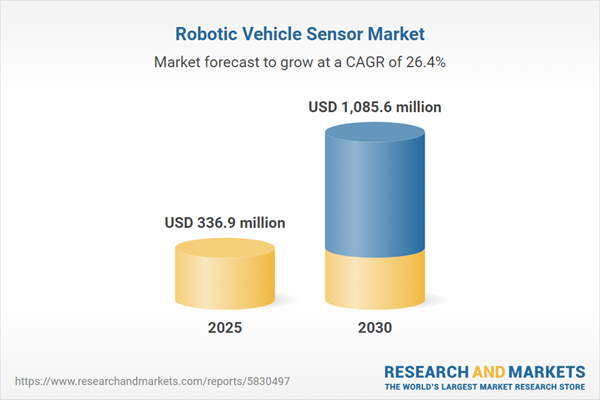The robotic vehicle sensor market is experiencing significant growth, driven by the increasing adoption of sensors in autonomous vehicles (AVs). The integration of advanced sensors such as radar, LiDAR, and cameras is critical to enabling autonomous driving capabilities, fueling demand for these technologies. The global electric vehicle (EV) market, a key driver of this demand, is projected to reach USD 1.31 trillion by 2028, according to the India Brand Equity Foundation. This expansion in the EV sector is expected to further accelerate the need for robotic vehicle sensors, as they are essential for vehicle perception, navigation, and safety systems.
Market Growth Drivers
Government Initiatives
Government support plays a pivotal role in the market's growth. For instance, the National Institute of Standards and Technology (NIST) in the United States is advancing its Automated Vehicle (AV) Programme, funded by the SERI initiative. This program focuses on improving system performance and measurement methods for AV sensors, perception systems, artificial intelligence (AI), cybersecurity, and communications. It also includes the development of a system interaction testbed to evaluate how AV systems interact, building on previous efforts to standardize and enhance autonomous vehicle technologies. Such initiatives create a favorable environment for the development and adoption of robotic vehicle sensors.Investments in Robotics
Significant investments in the robotics industry are also driving market growth. Governments and private sectors are channeling funds into research and development to advance robotic technologies, including sensors. These investments aim to enhance innovation, improve industrial capabilities, and expand the application of robotics across various sectors. For example, national strategies in leading economies are fostering the development of high-end robotic products, optimizing industry structures, and increasing the availability of advanced sensors, which directly supports the growth of the robotic vehicle sensor market.Geographical Outlook
Asia-Pacific: China's Dominance
China is poised to be the fastest-growing market for robotic vehicle sensors in the Asia-Pacific region. The country's leadership in manufacturing robots and sensors is underpinned by its robust consumer electronics industry and access to raw materials. China's manufacturing base supports sensor production for diverse applications, including defense, aerospace, and industrial sectors. The high production volume of robotics in China further contributes to market growth. The country's focus on expanding its robotics ecosystem, coupled with its manufacturing prowess, positions it as a global leader in the robotic vehicle sensor market.The robotic vehicle sensor market is on a strong growth trajectory, propelled by the rising demand for autonomous vehicles and the expansion of the global EV market. Government initiatives, such as NIST's AV Programme, and substantial investments in robotics are key catalysts. China's dominance in the Asia-Pacific region, driven by its manufacturing capabilities and robotics production, further accelerates market expansion. As autonomous vehicle technologies advance, the demand for sophisticated sensors is expected to grow, making this a critical area for industry stakeholders to monitor.
Key Benefits of this Report:
- Insightful Analysis: Gain detailed market insights covering major as well as emerging geographical regions, focusing on customer segments, government policies and socio-economic factors, consumer preferences, industry verticals, and other sub-segments.
- Competitive Landscape: Understand the strategic maneuvers employed by key players globally to understand possible market penetration with the correct strategy.
- Market Drivers & Future Trends: Explore the dynamic factors and pivotal market trends and how they will shape future market developments.
- Actionable Recommendations: Utilize the insights to exercise strategic decisions to uncover new business streams and revenues in a dynamic environment.
- Caters to a Wide Audience: Beneficial and cost-effective for startups, research institutions, consultants, SMEs, and large enterprises.
What do businesses use our reports for?
Industry and Market Insights, Opportunity Assessment, Product Demand Forecasting, Market Entry Strategy, Geographical Expansion, Capital Investment Decisions, Regulatory Framework & Implications, New Product Development, Competitive Intelligence.Report Coverage:
- Historical data from 2020 to 2024 & forecast data from 2025 to 2030
- Growth Opportunities, Challenges, Supply Chain Outlook, Regulatory Framework, and Trend Analysis
- Competitive Positioning, Strategies, and Market Share Analysis
- Revenue Growth and Forecast Assessment of segments and regions including countries
- Company Profiling: Strategies, Products, Financial Information, and Key Developments among others
Different segments covered under the robotic vehicle sensor market report are as below:
By Type
- Radar
- LiDAR
- Camera
- Ultrasonic Sensors
- Others
By Level of Automation
- L1/L2
- L3
- L4/L5
By Application
- Passenger Vehicles
- Commercial Vehicles
- Industrial/Off-Road Vehicles
- Logistics and Warehousing
- Public Transportation
By Vehicle Type
- Electric Vehicles (EVs)
- Internal Combustion Engine (ICE) Vehicles
- Hybrid Vehicles
By Geography
- North America
- USA
- Canada
- Mexico
- South America
- Brazil
- Argentina
- Others
- Europe
- Germany
- France
- United Kingdom
- Spain
- Others
- Middle East and Africa
- Saudi Arabia
- UAE
- Others
- Asia Pacific
- China
- Japan
- India
- South Korea
- Indonesia
- Thailand
- Others
Table of Contents
Companies Mentioned
- OSRAM Opto Semiconductors GmbH
- Ouster, Inc.
- Velodyne Lidar
- LeddarTech Inc.
- Continental AG
- Valeo
- Innoviz Technologies, LTD.
- Benewake (Beijing) Co., Ltd
Table Information
| Report Attribute | Details |
|---|---|
| No. of Pages | 142 |
| Published | August 2025 |
| Forecast Period | 2025 - 2030 |
| Estimated Market Value ( USD | $ 336.9 million |
| Forecasted Market Value ( USD | $ 1085.6 million |
| Compound Annual Growth Rate | 26.3% |
| Regions Covered | Global |
| No. of Companies Mentioned | 8 |









